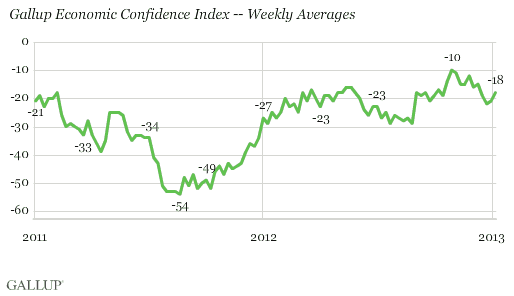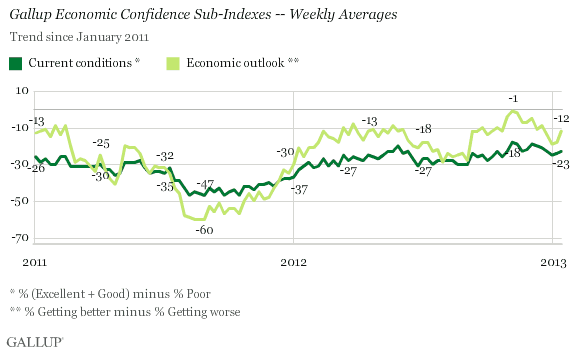PRINCETON, NJ -- Gallup's U.S. Economic Confidence Index averaged -18 the week of Jan. 7-13, a bit less negative than the -21 the prior week. Confidence remains lower than it was in the final weeks before, and first few weeks after, the 2012 presidential election. However, the current reading is among the more positive in the last two years.

Gallup's Economic Confidence Index is based on Americans' assessments of current economic conditions and their perceptions of whether the economy is getting better or worse. It has a theoretical minimum of -100 and a theoretical maximum of +100. Since Gallup began tracking confidence daily in 2008 -- just after the recession officially began -- it has yet to reach positive territory. The -10 score in the week before the 2012 election is the most positive weekly average to date.
Americans remain more negative than positive about current conditions and the economy's direction. Last week, 16% described current conditions as excellent and 39% as poor, for a net -23 current conditions score. Americans were a bit more upbeat about the nation's economic course, with 41% saying the economy was getting better and 53% worse, for a -12 economic outlook score.
All of the improvement in economic confidence from the prior week came on the outlook dimension, which was -18 (39% getting better, 57% getting worse) for Jan. 1-6 Gallup Daily tracking.
The pattern of Americans' economic outlook being less negative than their evaluations of current conditions has been the case nearly continuously since December 2011. However, prior to that -- from July through December 2011 -- the opposite was true, as Americans at that time were more negative about the economy's direction than its current state. Those more negative economic outlook readings came as the federal government reached an agreement to raise the nation's debt ceiling in late July and early August, which was soon followed by the downgrading of the U.S. credit rating and a drop in stock values. At that time, unemployment also remained high, at 9.0%, according to government figures.

Implications
Americans' confidence in the economy is higher on a relative basis than at almost any point in the last five years, though Americans remain more negative than positive in their overall evaluations of the economy. There are certainly positive signs in the economy, such as lower unemployment, modest economic growth, and an improving housing market. Still, even those indicators of economic health are hardly indicative of a strong economy.
The more positive feelings about the economy peaked around the time of the election, but began to fade in mid- to late December, perhaps due to concerns about the lack of an agreement to avoid the "fiscal cliff" tax increases and spending cuts. Now that an agreement has been reached, confidence has changed little, perhaps because Congress dealt mainly with the fiscal cliff tax increases while postponing more concrete action on spending cuts. The president and Congress are also faced with the need to raise the federal debt ceiling again, and the government's ability to deal with both issues could have an impact on Americans' economic confidence.
Gallup.com reports results from these indexes in daily, weekly, and monthly averages and in Gallup.com stories. Complete trend data are always available to view and export in the following charts:
Daily: Employment, Economic Confidence, Job Creation, Consumer Spending
Weekly: Employment, Economic Confidence, Job Creation, Consumer Spending
Read more about Gallup's economic measures.
View our economic release schedule.
Survey Methods
Results are based on telephone interviews conducted as part of Gallup Daily tracking Jan. 7-13, 2013, with a random sample of 3,561 adults, aged 18 and older, living in all 50 U.S. states and the District of Columbia.
For results based on the total sample of national adults, one can say with 95% confidence that the maximum margin of sampling error is ±2 percentage points.
Interviews are conducted with respondents on landline telephones and cellular phones, with interviews conducted in Spanish for respondents who are primarily Spanish-speaking. Each sample includes a minimum quota of 250 cellphone respondents and 250 landline respondents per 500 national adults, with additional minimum quotas by region. Landline telephone numbers are chosen at random among listed telephone numbers. Cellphone numbers are selected using random-digit-dial methods. Landline respondents are chosen at random within each household on the basis of which member had the most recent birthday.
Samples are weighted by gender, age, race, Hispanic ethnicity, education, region, adults in the household, population density, and phone status (cellphone only/landline only/both, cellphone mostly, and having an unlisted landline number). Demographic weighting targets are based on the March 2012 Current Population Survey figures for the aged 18 and older non-institutionalized population living in U.S. telephone households. All reported margins of sampling error include the computed design effects for weighting.
In addition to sampling error, question wording and practical difficulties in conducting surveys can introduce error or bias into the findings of public opinion polls.
For more details on Gallup's polling methodology, visit www.gallup.com.
